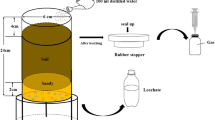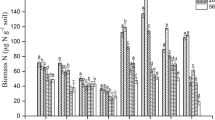Abstract
Ethanol production results in distiller grain, and biodiesel produces glycerol as by-product. However, there is limited information on effects of their addition on evolution of N2O and CO2 from soils, yet it is important to enable our understanding of impacts of biofuel production on greenhouse gas budgets. The objective of this study was to evaluate the direct effects of adding wet distillers grain (WDG), thin stillage (TS), and glycerol at three rates on greenhouse gas emissions (N2O and CO2) and nutrient supply rates in a cultivated soil from the Canadian prairies. The WDG and TS application rates were: 100, 200, or 400 kg N ha−1, whereas glycerol was applied at: 40, 400, or 4,000 kg C ha−1 applied alone (G − N) or in a combination with 300 kg N ha−1 (G + N). In addition, conventional amendments of urea (UR) and dehydrated alfalfa (DA) were added at the same rates of total N as the by-products for comparative purposes. The production of N2O and CO2 was measured over an incubation period of 10 days in incubation chambers and Plant Root Simulator™ resin membrane probes were used to measure nutrient (NH +4 -N, NO −3 -N, and PO −34 -P) supply rates in the soil during incubation. Per unit of N added, urea tended to result in the greatest N2O production, followed by wet distillers grain and thin stillage, with glycerol and dehydrated alfalfa resulting in the lowest N2O production. Cumulative N2O production increased with increasing the rate of N-containing amendments and was the highest at the high rate of UR treatment. Addition of urea with glycerol contributed to a higher rate of N2O emission, especially at the low rate of glycerol. The DA and WDG resulted in the greatest evolution of CO2 from the soil, with the thin stillage resulting in less CO2 evolved per unit of N added. Addition of N fertilizer along with glycerol enhanced microbial activity and decomposition. The amendments had significant impacts on release of available nutrient, with the UR treatments providing the highest NO −3 -N supply rate. The TS treatments supplied the highest rate of NH +4 -N, followed by WDG compared to the other amendments. The WDG treatments were able to provide the greatest supply of PO −34 -P supply in comparison to the other amendments. Microbial N immobilization was associated with glycerol treatments applied alone. This study showed that the investigated biofuel by-products can be suitable soil amendments as a result of their ability to supply nutrients and N2O emissions that did not exceed that of the conventional urea fertilizer.





Similar content being viewed by others
References
Ajwa HA, Tabatabai MA (1994) Decomposition of different organic materials in soils. Biol Fertil Soils 18:175–182
Akiyama H, Tsuruta H (2003) Nitrous oxide, nitric oxide, and nitrogen dioxide fluxes from soils after manure and urea application. J Environ Qual 32:423–431
Alotaibi KD, Schoenau JJ (2011) Enzymatic activity and microbial biomass in soil amended with biofuel production byproducts. Appl Soil Ecol 48:227–235
Aulakh MS, Doran JW, Walter DT, Mosier AR, Francis DD (1991) Crop residue type and placement effects on denitrification and mineralization. Soil Sci Soc Am J 55:1020–1025
Azam F, Müller C, Weiske A, Benckiser G, Ottow JCG (2002) Nitrification and denitrification as sources of atmospheric nitrous oxide—role of oxidizable carbon and applied nitrogen. Biol Fertil Soils 35:54–61
Bonnardeaux J (2007) Potential uses for distillers grains. Department of Agriculture and Food, Government of Western Australia, pp 1–11. Available at: http://www.agric.wa.gov.au/objtwr/imported_assets/content/sust/biofuel/potentialusesgrains042007.pdf. Accessed 17 Apr 2012
Cannavo P, Richaume A, Lafolie F (2004) Fate of nitrogen and carbon in the vadose zone: in situ and laboratory measurements of seasonal variations in aerobic respiratory and denitrifying activities. Soil Biol Biochem 36:463–478
Cayuela ML, Oenema O, Kuikman PJ, Bakker RR, Van Groenigen JW (2010) Bioenergy by-products as soil amendments? Implications for carbon sequestration and greenhouse gas emissions. GCB Bioenergy 2:210–213
Chadwick DR, Pain BF, Brookman SKE (2000) Nitrous oxide and methane emissions following application of animal manures to grassland. J Environ Qual 29:277–287
Cochran VL, Sparrow EB, Schlentner SF, Knight CW (1997) Long-term tillage and crop residue management in the subarctic: fluxes of methane and nitrous oxide. Can J Soil Sci 77:565–570
Diacono M, Montemurro F (2010) Long-term effects of organic amendments on soil fertility. A review. Agron Sustain Dev 30:401–422
Ding W, Meng L, Yin Y, Cai Z, Zheng X (2007) CO2 emission in an intensively cultivated loam as affected by long-term application of organic manure and nitrogen fertilizer. Soil Biol Biochem 39:669–679
Edmeades DC (2003) The long-term effects of manures and fertilisers on soil productivity and quality: a review. Nutr Cycl Agroecosys 66:165–180
Flessa H, Beese F (1995) Effects of sugarbeet residues on soil redox potential and nitrous oxide emission. Soil Sci So Am J 59:1044–1051
Galvez A, Sinicco T, Cayuela ML, Mingorance MD, Fornasier F, Mondini C (2011) Short term effects of bioenergy by-products on soil C and N dynamics, nutrient availability and biochemical properties. Agric Ecosyst Environ. doi:10.1016/j.agee.2011.06.015
Gök M, Ottow JCG (1988) Effect of cellulose and straw incorporation in soil on total denitrification and nitrogen immobilization at initially aerobic and permanent anaerobic conditions. Biol Fertil Soils 5:317–322
Granli T, Bøckman OC (1994) Nitrous oxide from agriculture. Norweg J Agr Sci Supplement 12:7–128
Groesbeck CN, McKinney LJ, DeRouchey JM, Tokach MD, Goodband RD, Dritz SS, Nelssen JL, Duttlinger AW, Fahrenholz AC, Behnke KC (2008) Effect of crude glycerol on pellet mill production and nursery pig growth performance. J Anim Sci 86:2228–2236
Ham GA, Sock RA, Klopfenstein TJ, Larson EM, Shain DH, Huffman RP (1994) Wet corn distillers byproducts compared with dried. J Anim Sci 72:3246–3257
Hargreaves J, Adl M, Warman P (2008) A review of the use of composted municipal solid waste in agriculture. Agric Ecosyst Environ 123:1–14
Harris HL, Cupp AS, Roberts AJ, Funston RN (2008) Utilization of soybeans or corn milling by-products in beef heifer development diets. J Anim Sci 86:476–482
Herman WA, McGill WB, Dormaar JF (1977) Effects of initial chemical composition on decomposition of roots of three grass species. Can J Soil Sci 57:205–215
Huang Y, Zou J, Zheng X, Wang Y, Xu X (2004) Nitrous oxide emissions as influenced by amendment of plant residues with different C:N ratios. Soil Biol Biochem 36:973–981
Janzen HH, Kucey RMN (1988) C, N, and S mineralization of crop residues as influenced by crop species and nutrient regime. Plant Soil 106:35–41
Jarecki MK, Parkin TB, Chan ASK, Hatfield JL, Jones R (2008) Greenhouse gas emissions from two soils receiving nitrogen fertilizer and swine manure slurry. J Environ Qual 37:1432–1438
Johnson J, Franzluebbers A, Weyers S, Reicosky D (2007) Agricultural opportunities to mitigate greenhouse gas emissions. Environ Pollut 150:107–124
Jones SK, Rees RM, Skiba UM, Ball BC (2005) Greenhouse gas emissions from a managed grassland. Global and Planet Change 47:201–211
Khalil MI, Rosenani AB, Cleemput OV, Boeckx P, Shamshuddin J, Fauziah CI (2002) Nitrous oxide production from an ultisol of the humid tropics treated with different nitrogen sources and moisture regimes. Biol Fertil Soils 36:59–65
Lammers PJ, Kerr BJ, Weber TE, Dozier WA, Kidd MT, Bregendahl K, Honeyman MS (2007) Digestible and metabolizable energy of crude glycerol for growing pigs. J Anim Scie 86:602–608
Lemke RL, Izaurralde RC, Nyborg M, Solberg ED (1999) Tillage and N source influence soil-emitted nitrous oxide in the Alberta Parkland region. Can J Soil Sci 79:15–24
Littell RC, Henry PR, Ammerman CB (1998) Statistical analysis of repeated measures data using SAS procedures. J Anim Sci 76:1216–1231
McKenney DJ, Wang SW, Drury CF, Findlay WI (1993) Dentrification and mineralization in soil amended with legume, grass, and corn residues. Soil Sci Soc Am J 57:1013–1020
Meijide A, Díez JA, Sánchez-Martín L, López-Fernández S, Vallejo A (2007) Nitrogen oxide emissions from an irrigated maize crop amended with treated pig slurries and composts in a Mediterranean climate. Agric Ecosyst Environ 121:383–394
Meng L, Ding W, Cai Z (2005) Long-term application of organic manure and nitrogen fertilizer on N2O emissions, soil quality and crop production in a sandy loam soil. Soil Biol Biochem 37:2037–2045
Moore AD, Alva AK, Collins HP, Boydston RA (2010) Mineralization of nitrogen from biofuel by-products and animal manures amended to a sandy soil. Commun Soil Sci Plant Anal 41:1315–1326
Muhammad W, Vaughan SM, Dalal RC, Menzies NW (2011) Crop residues and fertilizer nitrogen influence residue decomposition and nitrous oxide emission from a Vertisol. Biol Fertil Soils 47:15–23
Müller C, Stevens RJ, Laughlin RJ, Jäger HJ (2004) Microbial processes and the site of N2O production in a temperate grassland soil. Soil Biol Biochem 36:453–461
Nelson JDJ, Schoenau JJ, Malhi SS, Gill KS (2007) Burning and cultivation effects on greenhouse gas emissions and nutrients in wetland soils from Saskatchewan, Canada. Nutr Cycl Agroecosys 78:291–303
Nelson KA, Motavalli PP, Smoot RL (2009) Utility of dried distillers grain as a fertilizer source for corn. J Agric Sci 1:3–12
Qian P, Schoenau JJ (2002) Practical applications of ion exchange resins in agricultural and environmental soil research. Can J Soil Sci 82:9–21
Qian P, Schoenau JJ (2008) Effect of soil amendment with alfalfa pellets and glycerol on nutrition and growth of wheat. Proceedings of the 2008 Soils and Crops Workshop, February 28–29, University of Saskatchewn, Saskatoon, Saskatchewan. (on CD)
Qian P, Schoenau JJ, King T, Fatteicher C (2011) Effect of soil amendment with alfalfa powders and distillers grains on nutrition and growth of canola. J Plant Nutr 34:1403–1417
Quilty JR, Cattle SR (2011) Use and understanding of organic amendments in Australian agriculture: a review. Soil Res 49:1–26
Rausch KD, Belyea RL (2006) The future of coproducts from corn processing. App Biochem Biotechnol 128:47–86
Recous S, Robi D, Darwis D, Mary B (1995) Soil inorganic N availability: effect on maize residue decomposition. Soil Biol Biochem 27:1529–1538
Reddy KR, Khaleel R, Overcash MR (1980) Carbon transformations in the land areas receiving organic wastes in relation to nonpoint source pollution: a conceptual model. J Environ Qual 9:434–442
Reinertsen SA, Elliott LF, Cochran VL, Campbell GS (1984) Role of available carbon and nitrogen in determining the rate of wheat straw decomposition. Soil Biol Biochem 16:459–464
Sakala WD, Cadisch G, Giller KE (2000) Interactions between residues of maize and pigeonpea and mineral N fertilizers during decomposition and N mineralization. Soil Biol Biochem 32:679–688
Schimel J, Holland EA (2005) Global gases. In: Sylvia DM, Fuhrmann JJ, Hartel PG, Zuberer DA (eds) Principles and applications of soil microbiology, 2nd edn. Pearson, Upper Saddle River, pp 491–509
Schoenau JJ, Davis JG (2006) Optimizing soil and plant responses to land-applied manure nutrients in the Great Plains of Norht America. Can J Soil Sci 86:587–595
Serrano-Silva N, Luna-Guido M, Fernández-Luqueño F, Marsch R, Dendooven L (2011) Emission of greenhouse gases from an agricultural soil amended with urea: a laboratory study. Appl Soil Ecol 47:92–97
Shelp ML, Beauchamp EG, Thurtell GW (2000) Nitrous oxide emissions from soil amended with glucose, alfalfa, or corn residues. Commun Soil Sci Plant Anal 31:877–892
Skiba U, Smith KA (2000) The control of nitrous oxide emissions from agricultural and natural soils. Chemosphere Global Change Sci 2:379–386
The Glycerol Challenge (2007). Available at http://theglycerolchallenge.org
Velthof GL, Kuikman PJ, Oenema O (2003) Nitrous oxide emission from animal manures applied to soil under controlled conditions. Biol Fertil Soils 37:221–230
Zelles L, Adrian P, Bai QY, Stepper K, Adrian MV, Fischer K, Maier A, Ziegler A (1991) Microbial activity measured in soils stored under different temperature and humidity conditions. Soil Biol Biochem 23:955–962
Acknowledgments
Support of Saskatchewan Agriculture Development Fund and King Saud University scholarship program is greatly appreciated. Assistance provided by Dr. P. Qian and Cory Fatteicher is also acknowledged. The authors are also grateful to the editor, Dr. Paolo Nannipieri and two anonymous reviewers for their constructive comments and suggestions, which improved the quality of the paper.
Author information
Authors and Affiliations
Corresponding author
Rights and permissions
About this article
Cite this article
Alotaibi, K.D., Schoenau, J.J. Greenhouse gas emissions and nutrient supply rates in soil amended with biofuel production by-products. Biol Fertil Soils 49, 129–141 (2013). https://doi.org/10.1007/s00374-012-0704-3
Received:
Revised:
Accepted:
Published:
Issue Date:
DOI: https://doi.org/10.1007/s00374-012-0704-3




